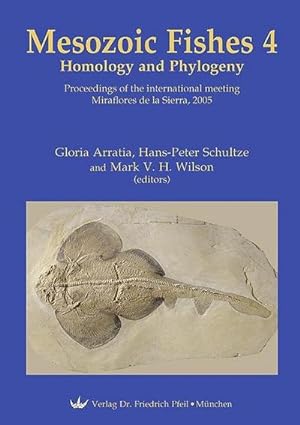Gloria Arratia Hans Peter Schultze Mark (1 results)
Product Type
- All Product Types
- Books (1)
- Magazines & Periodicals
- Comics
- Sheet Music
- Art, Prints & Posters
- Photographs
- Maps
-
Manuscripts &
Paper Collectibles
Condition
- All Conditions
- New
- Used
Binding
- All Bindings
- Hardcover
- Softcover
Collectible Attributes
- First Edition
- Signed
- Dust Jacket
- Seller-Supplied Images
- Not Printed On Demand
Seller Location
Seller Rating
-
Mesozoic Fishes 4 - Homology and Phylogeny : Homology and Phylogeny. Proceedings of the international meeting Miraflores de la Sierra, 2005
Published by Pfeil, 2008
ISBN 10: 3899370805ISBN 13: 9783899370805
Seller: AHA-BUCH, Einbeck, Germany
Book
Gebundene Ausgabe. Condition: Gebraucht. Gebraucht - Sehr gut Gelesenes Exemplar in sehr gutem Zustand - As in the previous volumes of Mesozoic Fishes, we begin by stating that 'The Mesozoic was an important time in the evolution of chondrichthyan and actinopterygian fishes because it was then that most modern groups first entered the fossil record and began to radiate'. Gloria ARRATIA initiated the international meeting 'Mesozoic Fishes' in August of 1993 in Eichstätt, and the first book, 'Mesozoic Fishes - Systematics and Paleoecology', was published in 1996. The next meetings followed in 1997 in Buckow, 2001 in Serpiano, and 2005 in Miraflores de la Sierra. Each of these meetings was followed by the publication of a book, so that 'Mesozoic Fishes 2 - Systematics and the Fossil Record' was published in 1999, and 'Mesozoic Fishes 3 - Systematics, Paleoenvironments and Biodiversity' was published in 2004. The editors of these books included the principal organizer of the meeting and Gloria ARRATIA. The content of the first three books on Mesozoic fishes reveals some patterns in the research on Mesozoic fishes. Studies concerning the phylogenetic relationships of different fish groups often include both fossil and recent fishes so that the studies are not restricted only to Mesozoic forms. Almost all of these studies have been based on morphological evidence; however, papers dealing with specific morphological structures have also been welcomed in previous books. The majority of researchers are involved in work on Mesozoic actinopterygians, whereas fewer study Mesozoic chondrichthyans, and even fewer study sarcopterygians. Among the actinopterygians, subjects of studies vary from basal neopterygians to teleosts. Descriptions of new taxa, as well as new information concerning oldest records for different fish groups, are important components of 'Mesozoic Fishes'. The present book offers some major changes in comparison to previous volumes. Most contributors to Mesozoic Fishes prefer that the meetings and books be separate events and that the series of books be managed by permanent editors. The content of this and subsequent books will be mainly based on the papers presented at the meetings, but not exclusively, in that some colleagues may be invited by the editors to write specific chapters. Experience has shown that despite the title of the meetings (and of the books), most papers concern systematics. The titles of previous meetings included other subjects, such as paleoenvironment and paleoecology, that are important to develop within the framework of Mesozoic fishes, but yielded almost no response from the participants; such a deficiency created a conflict between the title of the earlier volumes and their contents. Therefore, the title of the Fourth International meeting, 'Mesozoic Fishes 4 - Systematics, Homology, and Nomenclature', has not been retained for the present book because most papers in this volume deal with fish systematics and take a conservative approach to the interpretations of structures and to the nomenclature employed. Apparently, the position of many colleagues is that tradition should be maintained regardless of the progress in understanding of homologies that is made in their science. However, despite this general preference, three papers in this book deal with the concepts of homology, philosophical principles, and their application. 'Mesozoic Fishes 4 - Homology and Phylogeny' captures the current state of knowledge on Mesozoic fishes and illustrates the trends among fish workers in their areas of study. Although the number of contributions on chondrichthyans and actinopterygians has risen steadily, no new information on sarcopterygians is included. More than 10 new taxa are described and a few others are revised. For the first time, descriptions of new fossil neoteleosts are presented.


